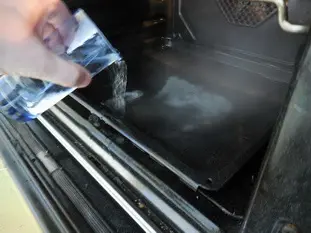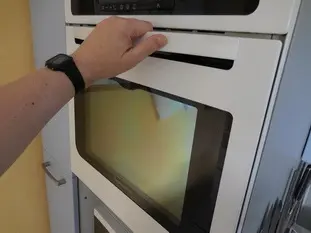This site uses only a few technical cookies necessary for its operation. By continuing to browse, you accept their use.
To find out more...
To find out more...
Steam for baking bread

What does steam have to do with bread-making? This is not only a bakers' secret, it is something you might not think of at all: if you make bread and bake it like a cake, you will end up with bread, but pale and with a thick, hard crust – a long way from the golden-brown crusty loaf you had in mind.
This is because, when baking bread in an oven, it is vital that right at the start, the loaf goes into an atmosphere that is hot, of course, (around 480°F or 250°C), but also very humid: saturated with steam, in fact. Some of the water suspended in the air inside the oven will settle out evenly on the bread and will react with the dough to form sugars (in the chemical sense). These will help brown the crust in the famous Maillard reactions, producing this bread a more appetising colour, but that is not all. It also helps to form a thin, crisp crust.
This is because, when baking bread in an oven, it is vital that right at the start, the loaf goes into an atmosphere that is hot, of course, (around 480°F or 250°C), but also very humid: saturated with steam, in fact. Some of the water suspended in the air inside the oven will settle out evenly on the bread and will react with the dough to form sugars (in the chemical sense). These will help brown the crust in the famous Maillard reactions, producing this bread a more appetising colour, but that is not all. It also helps to form a thin, crisp crust.
147 K 4.5/5 (38 reviews)
Last modified on: June 16th 2021
Steam for baking bread
So steam is indispensable: there are no beautifully browned, crusty loaves without it. You should note that once the crust is formed in the oven, after about 15 or 20 minutes, the steam is no longer necessary, so there is no need to keep adding it for the rest of the cooking time.
For amateur bakers like us, things are rather different, but here are a few ways to achieve a similar effect:
When you put the bread in the oven, before closing the door, pour a large glassful of water into the burning-hot tray (do be careful not to scald yourself),
If all the water has evaporated in under 15 minutes, add a second glassful.
To sum up: Without steam, no beautiful, good bread. You need to have steam in the oven during the first 15 minutes of baking.
Creating steam in the oven
Professional bakers have the advantage of a special "Steam" control on their electric ovens. This injects water into the oven, which lands on very hot metal elements and vaporises to create the steam. They simply press a button and “pshhhh!” , that's it.For amateur bakers like us, things are rather different, but here are a few ways to achieve a similar effect:
Conventional kitchen oven
For this set up, preheat the oven with an empty oven tray sitting directly on the bottom (oven floor or sole) and leave it in the oven to heat up.
When you put the bread in the oven, before closing the door, pour a large glassful of water into the burning-hot tray (do be careful not to scald yourself),


If all the water has evaporated in under 15 minutes, add a second glassful.
Bread oven
If you are fortunate enough to have a proper bread oven, you will need to use a special technique, shown on this page which explains the Steam Machine.To sum up: Without steam, no beautiful, good bread. You need to have steam in the oven during the first 15 minutes of baking.

Lasts posts
Butter vs. grease
We often read in a recipe where a pastry is put into a mould that, just before pouring, the mould should be buttered or greased. But what's the difference between these 2 terms?December 1st 20251,0665
Getting out of the fridge early
Very often when you're cooking, you need to take food or preparations out of the fridge, to use them in the recipe in progress. There's nothing tricky about this: you just take them out of the fridge and use them, usually immediately, in the recipe. But is this really a good method?November 24th 20251,1585
Who's making the croissants?
When you look at a bakery from the outside, you naturally think that in the bakery, the bakers make the bread, and in the laboratory, the pastry chefs make the cakes. It's very often like that, with each of these professions having quite different ways of working, but sometimes there's also one...November 23th 20251,053
Oven height
When we put a dish or cake in the oven, we naturally tend to put it on the middle shelf, and that's what we usually do. But in some cases, this position and height can be a little tricky, so let's find out why.October 8th 20252,8485
The importance of sieving
In recipes that use a fine powder (flour, powdered sugar, etc.), you'll often see the advice to sift before using it. To sift is to pass the powder in question through a sieve (a very fine strainer) before incorporating it into your recipe. It's often advice, but is it really useful?September 3rd 20257,5903
Other pages you may also like
A few tips for effective kneading at home
When you have to knead dough for bread or some other recipe, you may well use a food processor or the type of machine known as a stand mixer. The best-known brands are Kenwood and KitchenAid. They are useful tools, but here are a few tips to help you get the best out of them.June 23th 2021284 K 23.8
Candied fruits: don't get ripped off
Do you like candied fruit? You might like to nibble a handful or add it to a recipe, like a classic fruit cake or delicious Italian specialities like panettone or sicilian epiphany pie.June 21th 201767 K 24.2
The bitterness of endives
As I write these lines, we are entering the endive season, and if you like it, it's time to enjoy it, if possible with your local producers. Endive is good, but the reproach that is often made of it, and children in particular, is: "It's bitter! And it is (somewhat) true of course, endives...February 9th 201914 K4.9
What is the difference between bakery and patisserie?
This is a question that you may well have asked yourself and which I will attempt to answer. In France the two trades of "boulangerie" (bakery) and "pâtisserie" (patisserie and confectionery) have always been quite distinct, but where exactly do the boundaries lie? .February 7th 2017134 K 14.1
Egg yolks and caster sugar
We often come across recipes where we need to mix egg yolks with caster sugar. This would appear to be a very ordinary and simple thing to do but, be warned, these two ingredients can behave oddly together.February 15th 201883 K 24.3
Post a comment or question
Follow this page (as 11 people already do)
If you are interested in this page, you can "follow" it, by entering your email address here. You will then receive a notification immediately each time the page is modified or a new comment is added. Please note that you will need to confirm this following.
Note: We'll never share your e-mail address with anyone else.
Alternatively: you can subscribe to the mailing list of cooling-ez.com , you will receive a e-mail for each new recipe published on the site.









